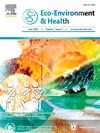Diagnostic performance of allele-specific RT-qPCR and genomic sequencing in wastewater-based surveillance of SARS-CoV-2
引用次数: 0
Abstract
Clinical genomic surveillance is regarded as the gold standard for monitoring SARS-CoV-2 variants globally. However, as the pandemic wanes, reduced testing poses a risk to effectively tracking the trajectory of these variants within populations. Wastewater-based genomic surveillance that estimates variant frequency based on its defining set of alleles derived from clinical genomic surveillance has been successfully implemented. This method has its challenges, and allele-specific (AS) RT-qPCR or RT-dPCR may instead be used as a complementary method for estimating variant prevalence. Demonstrating equivalent performance of these methods is a prerequisite for their continued application in current and future pandemics. Here, we compared single-allele frequency using AS-RT-qPCR, to single-allele or haplotype frequency estimations derived from amplicon-based sequencing to estimate variant prevalence in wastewater during emergent and prevalent periods of Delta, Omicron, and two sub-lineages of Omicron. We found that all three methods of frequency estimation were concordant and contained sufficient information to describe the trajectory of variant prevalence. We further confirmed the accuracy of these methods by quantifying the diagnostic performance through Youden's index. The Youden's index of AS-RT-qPCR was reduced during the low prevalence period of a particular variant while the same allele in sequencing was negatively influenced due to insufficient read depth. Youden's index of haplotype-based calls was negatively influenced when alleles were common between variants. Coupling AS-RT-qPCR with sequencing can overcome the shortcomings of either platform and provide a comprehensive picture to the stakeholders for public health responses.

等位基因特异性RT-qPCR和基因组测序在基于废水的SARS-CoV-2监测中的诊断价值
临床基因组监测被认为是全球监测SARS-CoV-2变异的金标准。然而,随着大流行的减弱,检测的减少对有效追踪人群中这些变异的轨迹构成了风险。基于废水的基因组监测已经成功实施,该监测基于临床基因组监测得出的等位基因的定义集来估计变异频率。这种方法有其挑战,等位基因特异性(AS) RT-qPCR或RT-dPCR可以作为估计变异流行率的补充方法。证明这些方法的同等性能是在当前和未来大流行病中继续应用这些方法的先决条件。在这里,我们使用AS-RT-qPCR将单等位基因频率与基于扩增子测序的单等位基因或单倍型频率进行比较,以估计Delta、Omicron和Omicron的两个亚谱系在突发性和流行期废水中的变异发生率。我们发现所有三种频率估计方法是一致的,并且包含足够的信息来描述变异流行的轨迹。我们通过约登指数对诊断性能进行量化,进一步证实了这些方法的准确性。AS-RT-qPCR的约登指数在特定变异的低流行期降低,而同一等位基因在测序中由于读取深度不足而受到负面影响。当等位基因在变体之间相同时,基于单倍型的呼叫的约登指数受到负向影响。将AS-RT-qPCR与测序相结合可以克服任一平台的缺点,并为公共卫生反应的利益攸关方提供全面的情况。
本文章由计算机程序翻译,如有差异,请以英文原文为准。
求助全文
约1分钟内获得全文
求助全文
来源期刊

Eco-Environment & Health
环境科学与生态学-生态、环境与健康
CiteScore
11.00
自引率
0.00%
发文量
18
审稿时长
22 days
期刊介绍:
Eco-Environment & Health (EEH) is an international and multidisciplinary peer-reviewed journal designed for publications on the frontiers of the ecology, environment and health as well as their related disciplines. EEH focuses on the concept of “One Health” to promote green and sustainable development, dealing with the interactions among ecology, environment and health, and the underlying mechanisms and interventions. Our mission is to be one of the most important flagship journals in the field of environmental health.
Scopes
EEH covers a variety of research areas, including but not limited to ecology and biodiversity conservation, environmental behaviors and bioprocesses of emerging contaminants, human exposure and health effects, and evaluation, management and regulation of environmental risks. The key topics of EEH include:
1) Ecology and Biodiversity Conservation
Biodiversity
Ecological restoration
Ecological safety
Protected area
2) Environmental and Biological Fate of Emerging Contaminants
Environmental behaviors
Environmental processes
Environmental microbiology
3) Human Exposure and Health Effects
Environmental toxicology
Environmental epidemiology
Environmental health risk
Food safety
4) Evaluation, Management and Regulation of Environmental Risks
Chemical safety
Environmental policy
Health policy
Health economics
Environmental remediation
 求助内容:
求助内容: 应助结果提醒方式:
应助结果提醒方式:


